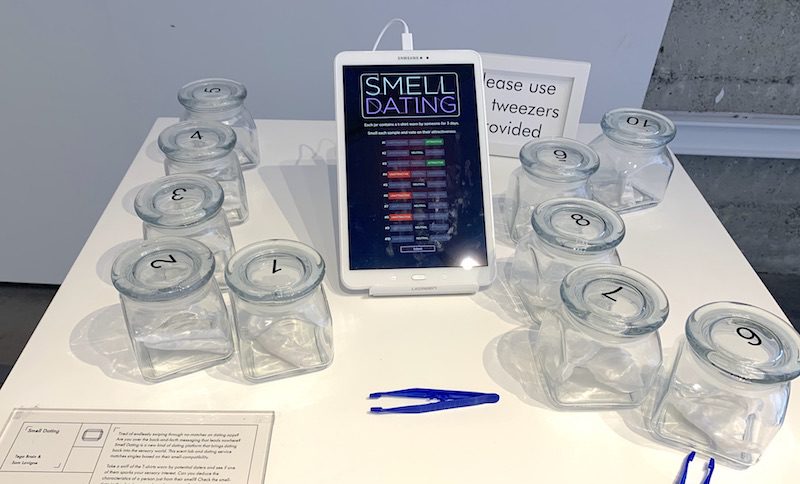 (Photo: Lucas Saugen/The Glass Room)
(Photo: Lucas Saugen/The Glass Room)
If you weren’t able to visit the intriguing pop-up exhibition called “The Glass Room,” which toured the world before closing in San Francisco last month, fear not. I got to go three times and was inspired to share highlights you can explore from your very own screen.
Nestled in the middle of San Francisco’s shopping district, “The Glass Room” occupied the old Converse shop on Market Street. The room’s design and layout mimicked an Apple store. Employees were dubbed “Ingeniuses” and there was even a Data Detox Bar in the back.
Tactical Tech, an international non-profit organization that explores the impacts of technology on society, created “The Glass Room.” The exhibit challenges our assumptions about data privacy and reveals just how passive many of us have become in our acceptance of technology’s rules of engagement.
Smell Dating

One highlight for me was a piece called “Smell Dating,” by artists Tega Brain and Sam Lavigne. With apps such as Tinder or Hinge, our next relationship is just one right-swipe away, right? But think of the data those apps use to decide your match. “Smell Dating” playfully introduces a new kind of dating platform that replaces the usual measures of compatibility — music tastes, favorite activities, that kind of thing — with smell. The piece has you sniff 10 t-shirt samples worn by anonymous potential lovers and rate each t-shirt’s appeal as “unattractive,” “neutral,” or “attractive.” To know how someone smells before knowing anything else about them (i.e., their name, gender, age, sexual preferences, etc.) feels extremely personal and a little violating — and maybe that’s the point, as it forces us to see how much of ourselves we give away on these apps. Or is “Smell Dating” just the 4D dating experience the world has been missing?
Quick Fix
(Photo: Marjerrie Masicat/YR Media)
Another favorite was a piece called “Quick Fix,” a vending machine that lets you buy Instagram followers or likes for just a few dollars, assigning a monetary value to social influence. “Does this actually work?” I heard lots of people ask as they viewed the piece, and I wondered the same thing. With an audience watching over my shoulder, I nervously inserted three dollars’ worth of quarters into the machine. When the last one went in, I entered my information, and within a minute, I garnered 300 likes on my latest post. It was a little awkward, buying likes in a public venue, but imagine how easy it would be in the privacy of your own home.
Invisible Labor
The most overlooked and thought-provoking part of the exhibit for me was “Invisible Labor.” Many of us use products such as Google, Facebook, Instagram and Twitter every day. These companies track our data — which we freely provide just by scrolling down or conducting a search — to learn more about us and improve their services. But really: are massive companies truly invested in the betterment of our experiences as an end in itself? Or are they driven to privatize and sell our data for profit that largely benefits them? Whether we like it or not, we are all a gigantic, non-stop focus group and the test is how we interact with their latest application. What would happen if companies paid us for our data? “Invisible Labor” reveals the hidden costs of tech to ourselves and our environment.
Total Data Detox?
Overall, like all the best art exhibits, “The Glass Room” left me with lots of questions, like: how do you get people to actually care about the information we share and what would it take to get us to change our behaviors?
In my case, after “The Glass Room,” I became more conscious of my data habits. Following steps from the Data Detox Kit, I was able to take back ownership of some of my data. Even though I’m now more aware of data privacy and how companies use this information, I still find it difficult to imagine a world without relying on the tech giants. The life conveniences they provide are my greatest vice.